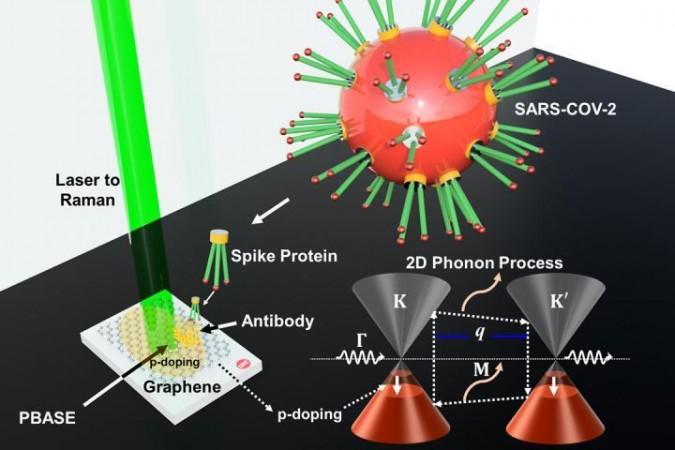The COVID-19 pandemic has established without a doubt that timely and accurate detection is key in the fight against the SARS-CoV-2 coronavirus and its aggressively emerging variants. Therefore, researchers across the world are engaged in the development of diagnostic tests that are quick and precise. Now, a new study has reported the development of a new detection technique using the thinnest yet strongest known material—Graphene—that can identify the virus in below five minutes.
The study by scientists from the University of Illinois Chicago demonstrated a novel method involving the combining of graphene sheets and a spike-specific antibody was able to detect the virus in artificial saliva samples with high accuracy and speed. The study was published in the journal ACS Nano.
"This project has been an amazingly novel response to the need and demand for detection of viruses, quickly and accurately. The development of this technology as a clinical testing device has many advantages over the currently deployed and used tests," said Dr. Garrett Lindemann, co-author of the study, in a statement.
Toughest Material Known

Graphene is an allotrope—a different physical form—of carbon. It is a single or monolayer of carbon atoms, arranged in a two-dimensional honeycomb lattice. Being the strongest known material, graphene is harder than diamond and sturdier than steel. Yet, it is more elastic than rubber and is lighter than aluminum. The chemical bonds binding the carbon atoms imbibe possess elasticity and movement can create accurately measurable resonant vibrations known as phonons. When molecules such as the SARS-CoV-2 virus interact with chemically stable and highly conductive graphene, the resonant vibrations can undergo changes that are very specific and quantifiable.
"Graphene is just one atom thick, so a molecule on its surface is relatively enormous and can produce a specific change in its electronic energy. In this experiment, we modified graphene with an antibody and, in essence, calibrated it to react only with the SARS-CoV-2 spike protein. Using this method, graphene could similarly be used to detect COVID-19 variants," explained Dr. Vikas Berry, senior author of the study.
The carbon allotrope has seen use in the development of ultrasensitive biosensors that can sense protein misfolding and detect diseases such as Alzheimer's that they result in. Dr. Berry stated that graphene—which is often called a 'wonder material'—possesses properties that are unique and greatly versatile, making it ideal for creating sensors of this kind.
Detecting COVID-caused Changes In Vibrations

For the study, the authors integrated sheets of graphene—which are over 1,000 times sleeker than a regular postage stamp—with an antibody engineered to specifically target the notorious 'spike' protein of the SARS-CoV-2 virus. Next, the team measured the vibrations of these antibody-coupled sheets at an atomic level when they were exposed to COVID- and COVID+ and samples in artificial saliva.
The scientists discovered that the vibrations of the antibody-laden graphene sheet were altered when it was treated with samples that were positive for COVID-19. However, no changes in vibrations were observed when it was treated with samples that were negative for SARS-CoV-2, or with another coronavirus (MERS-CoV). Measured using a device known as 'Raman spectrometer', changes in vibrations were discernible in less than five minutes. According to the authors, the new optical platform can be adapted for other variants of the novel coronavirus and applied for other specific-binding-based biodetection.
"We have been developing graphene sensors for many years. In the past, we have built detectors for cancer cells and ALS. It is hard to imagine a more pressing application than to help stem the spread of the current pandemic. There is a clear need in society for better ways to quickly and accurately detect COVID and its variants, and this research has the potential to make a real difference. The modified sensor is highly sensitive and selective for COVID, and it is fast and inexpensive," emphasized Dr. Berry.

















